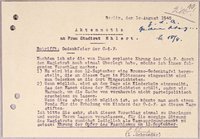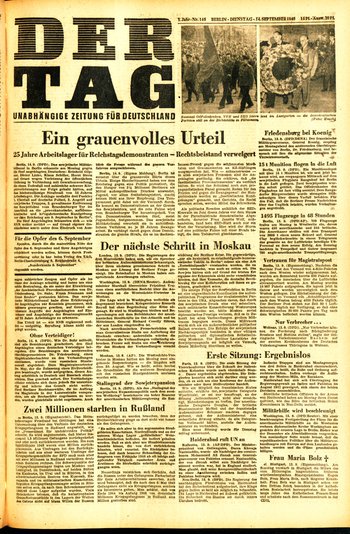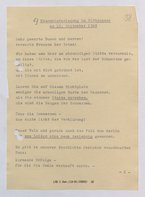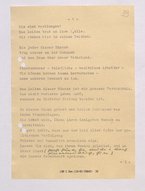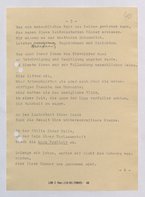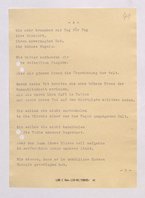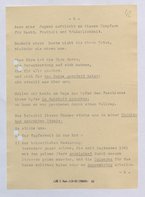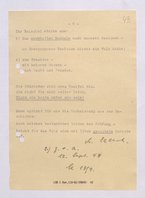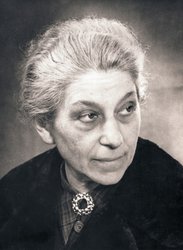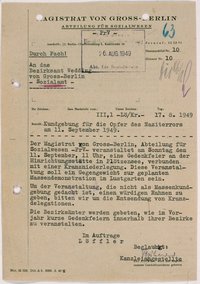Divided commemoration
The early commemorations in Plötzensee were strongly influenced by the Cold War. After the introduction of a new currency in the Western-occupied zones and the Soviet Union’s blockade of Berlin, the East-West conflict intensified in September 1948. Supporters of the Socialist Unity Party (SED) occupied Berlin’s city parliament, whereupon the non-communist part of the municipal administration moved to the Western sectors. A few days later, its members and selected guests gathered for a small memorial ceremony in Plötzensee on the Memorial Day for the Victims of Fascism. Meanwhile, the Association of Persecutees of the Nazi Regime (VVN) held its own large event in the Lustgarten, in the East of the city. This was the first time the memorial day was marked by separate events.
Proposal for a commemorative plaque
Originally, the municipal administration had only planned to install a commemorative plaque in Plötzensee on the Memorial Day for the Victims of Fascism. An event at the execution site was not scheduled. This and later other proposals for plaques bearing names of those murdered were not put into practice.
On September 9, 1948, Ernst Reuter held a speech for freedom at the Reichstag before more than 300,000 people, appealing to the “nations of the world” not to abandon West Berlin to communism and the Soviet Union. The Memorial Day for the Victims of Fascism took place three days later, under the direct influence of the tensions between East and West.
The CDU party newspaper Der Tag reports on the memorial day in Berlin on its front page. The photo on the top left shows the VVN event in the center of town; the photo on the right depicts the ceremony in Plötzensee with Margarete Ehlert, Otto Suhr, and Walter Löffler.
This was the first memorial ceremony at the historical site after 1945. Relatives of Nazi victims and representatives of municipal institutions, political parties, and organizations took part in the small ceremony. Speakers referred several times to their duty towards those murdered in Plötzensee to champion peace, justice, and freedom under the political circumstances of the day.
Speech in Plötzensee on September 12, 1948
The manuscript for Margarete Ehlert’s speech hints at the tense situation in Berlin at the time at several points. The city councilor refers to the men murdered in Plötzensee in her speech and also to other Nazi victims, mentioning in particular the persecution of Jews in Germany.
Margarete Ehlert June 23, 1886 – December 2, 1963
Margarete Ehlert was the director of the Reich Institute for Labor Placement and Unemployment Insurance until 1934, when the National Socialists forced her into retirement. She went on to head the social work section of the Catholic charity Caritas and to work for the German Catholic Women’s Association. From December 1946 to January 1949, the co-founder of the Christian Democratic Union party was a city councilor and head of Berlin’s social affairs department. She thus supervised the Main Office for Victims of Fascism, which organized the first memorial ceremony at the former execution site in September 1948. Margarete Ehlert was the first and for many years only woman to hold a speech here in memory of the victims of National Socialism.
Film sequences of the first memorial ceremony in 1948:
Unedited silent film footage exists of the memorial ceremony in Plötzensee on September 12, 1948, recorded for the weekly newsreel “Welt im Film.”
These excerpts show numerous participants at the event and the wreath delegation on the way to the former execution site. The speeches are held by the writer Hilde Körber and by Margarete Ehlert, Walter Löffler, and Otto Suhr.
The damage to the buildings is clearly visible. Part of the side wall and an area of the shed without a roof can also be seen at the end of the film. This area to the left of the execution room entrance was later demolished and is no longer visible today.
After the city authorities were officially divided, the West Berlin administration (later the Berlin senate) continued to hold memorial ceremonies for the victims of National Socialism at the former execution site. At these ceremonies, the Western part of the city distanced itself from the official events in Berlin’s Eastern sector. The announcement for the event on September 11, 1949 emphasizes that it was planned as a “counterweight” to the mass rally in the center of East Berlin. At the ceremony in Plötzensee, the later speakers were Mayor Ferdinand Friedensburg, the city council chairman Rudolf Markewitz, and the former prison chaplain Harald Poelchau.

